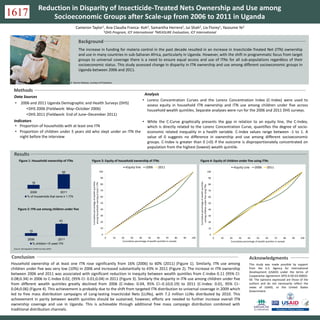
Reduction in Disparity of Insecticide-Treated Nets Ownership and Use among Socioeconomic Groups after Scale-up from 2006 to 2011 in Uganda
- 1. Background Reduction in Disparity of Insecticide-Treated Nets Ownership and Use among Socioeconomic Groups after Scale-up from 2006 to 2011 in Uganda Methods The increase in funding for malaria control in the past decade resulted in an increase in Insecticide-Treated Net (ITN) ownership and use in many countries in sub-Saharan Africa, particularly in Uganda. However, with the shift in programmatic focus from target groups to universal coverage there is a need to ensure equal access and use of ITNs for all sub-populations regardless of their socioeconomic status. This study assessed change in disparity in ITN ownership and use among different socioeconomic groups in Uganda between 2006 and 2011. Results • 2006 and 2011 Uganda Demographic and Health Surveys (DHS) •DHS 2006 (Fieldwork: May–October 2006) •DHS 2011 (Fieldwork: End of June–December 2011) • Proportion of households with at least one ITN • Proportion of children under 5 years old who slept under an ITN the night before the interview • Lorenz Concentration Curves and the Lorenz Concentration Index (C-Index) were used to assess equity in household ITN ownership and ITN use among children under five across household wealth quintiles. Separate analyses were run for the 2006 and 2011 DHS surveys. • While the C-Curve graphically presents the gap in relation to an equity line, the C-Index, which is directly related to the Lorenz Concentration Curve, quantifies the degree of socio- economic related inequality in a health variable. C-Index values range between -1 to 1. A value of 0 suggests no difference in ownership and use among different socioeconomic groups. C-Index is greater than 0 (<0) if the outcome is disproportionately concentrated on population from the highest (lowest) wealth quintile. Conclusion Household ownership of at least one ITN rose significantly from 16% (2006) to 60% (2011) (Figure 1). Similarly, ITN use among children under five was very low (10%) in 2006 and increased substantially to 43% in 2011 (Figure 2). The increase in ITN ownership between 2006 and 2011 was associated with significant reduction in inequity between wealth quintiles from C-Index 0.11 (95% CI: 0.08;0.34) in 2006 to C-Index 0.02, (95% CI: 0.01;0.04) in 2011 (Figure 3). Similarly the disparity in ITN use among children under five from different wealth quintiles greatly declined from 2006 (C-Index: 0.04, 95% CI:-0.10;0.19) to 2011 (C-Index: 0.01, 95% CI:- 0.04;0.06) (Figure 4). This achievement is probably due to the shift from targeted ITN distribution to universal coverage in 2009 which led to free mass distribution campaigns of Long-lasting Insecticidal Nets (LLINs), with 7.2 million LLINs distributed by 2010. This achievement in parity between wealth quintiles should be sustained; however, efforts are needed to further increase overall ITN ownership coverage and use in Uganda. This is achievable through additional free mass campaign distribution combined with traditional distribution channels. Acknowledgments This study was made possible by support from the U.S. Agency for International Development (USAID) under the terms of Cooperative Agreement GPO-A-00-03-00003- 00. The opinions expressed are those of the authors and do not necessarily reflect the views of USAID, or the United States Government. Data Sources Analysis Cameron Taylor1, Ana Claudia Franca- Koh2, Samantha Herrera2, Jui Shah2, Lia Florey1, Yazoume Ye2 1DHS Program, ICF International 2MEASURE Evaluation, ICF International Figure 1: Household ownership of ITNs © Bonnie Gillespie, courtesy of Photoshare Indicators 16 60 2006 2011 % of households that owns ≥ 1 ITN 0 10 20 30 40 50 60 70 80 90 100 0 10 20 30 40 50 60 70 80 90 100 Cumulativepercentageofwealthquintiles amonghouseholdsowningatleast1ITN Cumulative percentage of wealth quintiles in sample Equity line 2006 2011 10 43 2006 2011 % children <5 used ITN Source: Demographic Health Surveys (DHS) 0 10 20 30 40 50 60 70 80 90 100 0 10 20 30 40 50 60 70 80 90 100 Cumulativepercentageofwealthquintiles amongchildrenunder-fiveusingITNs Cumulative percentage of wealth quintiles in sample Equity Line 2006 2011 Figure 3: Equity of household ownership of ITNs Figure 4: Equity of children under five using ITNs Figure 2: ITN use among children under five 1617
